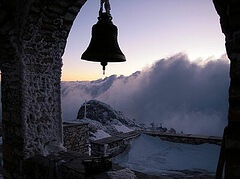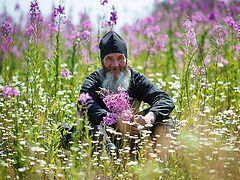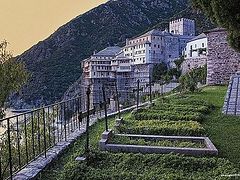A pilgrimage to the hesychastarion1 of St. Basil the Great in Katounakia or the fasters of the Karoulia Hermitage is enough to feel what spiritual heroism, overcoming nature, and love for God without barriers and restrictions mean. St. Nicodemus the Hagiorite in his service to the all the saints of Mt. Athos describes their connection with nature: “They preserved the natural, avoided the unnatural, and were awarded the supernatural gifts.” Even people who find it hard to believe in God unequivocally recognize the reverence evoked by a person who attained a state of theosis and became an icon of the incarnate God.2
Athonite tradition, among other things, is adorned with the lives of famous and unknown saints who lived as holy “fools for Christ’s sake”. In fact, every Athonite monk is a “fool for Christ’s sake” (cf. 1 Cor. 4:10). But the whole of Holy Mount Athos functions with a logic completely different from the secular one—the logic of the “foolishness of the Cross” (cf. 1 Cor. 1:18); of one who, when asked for a coat, will also sacrifice his cloak (cf. Mt. 5:40); one who in order to “save his life loses it for Christ’s and the Gospel’s sake” (cf. Mk. 9:35); one who consciously chooses the state of “blessed poverty (of spirit)” (cf. Lk. 6:20); and one who becomes last of all, and servant of all (cf. Mk. 9: 35); and least of all (cf. Lk. 9:48). Life on Mt. Athos has nothing to do with conditionality and compromise, so its logic is “a different one” that liberates and saves.
Spirituality on Mt. Athos also overcomes ethics. The monks live it in such a way that there is no fear in love; but perfect love casteth out fear (1 Jn. 4:18). The commandments are kept with faith and love, not grudgingly or of necessity (2 Cor. 9:7). On Mt. Athos you understand what it means to “give voluntarily.” Words such as guilt, remorse, threat, responsibility, fear and uncertainty express an understanding that is completely alien to Athonite ethics.
Mt. Athos inspires you with its humility and shame before the mystery of God and man. God’s will is not a command imposed on you that you must follow. It is unknown, and you need to find it in yourself. An authentic Athonite monk neither answers all questions, nor suggests solutions to all dilemmas, nor has proper arguments, nor speaks out on all topics. He speaks more with his silence and prayer than with his definitions, knowledge, genius and precise answers. As the Venerable Barsanuphius the Great (who, even when he advised something, radiated freedom) used to say: “I have not bound you, brother. I do not give you an order, but an opinion; do as you please.”3 In the face of an unknown mystery the feeling of knowledge is a daring that mortifies, whereas respect for the unknown is humility that liberates.
The same applies to sin, to a sinful and guilty person. An Athonite monk feels another person’s sin as his own; he is not guilty and, naturally, does not feel guilty. He simply feels that he is close to each of his brothers and before God with all people’s sins. Athonite spirituality passes through silent humility and freedom of apophaticism.
Prayer and theology
Mt. Athos is a place where life is connected exclusively with the theology of the second millennium. All theological works of this era have an Athonite seal.
Here the hesychast tradition was preserved and developed, with its main representative being St. Gregory Palamas, Archbishop of Thessaloniki. But the great fourteenth-century theoreticians of hesychasm, such as Sts. Nikephoros the Hesychast, Theoleptos of Philadelphia, Gregory of Sinai, Philotheos Kokkinos, Patriarch of Constantinople, Kallistos and Ignatios Xanthopoulos were linked to Mt. Athos in one way or another.4
Later, in the eighteenth century, the Philokalian tradition flourished here thanks to St. Nicodemus the Hagiorite and the Venerable Paisius Velichkovsky who made the Philokalia known and available to the Slavs, along with the Kollyvades movement.
Theological dynamics on Mt. Athos reached our relatively spiritually barren days, when modern wise monks and theologians, such as Archbishop Vasily (Krivoshein) of Brussels, the Venerable Sophrony (Sakharov), Silouan of Mt. Athos and Theoklitos of Dionysiou, Elders Emilianos of Simonopetra, George of Gregoriou and Vasilios of Iveron gave their experience of Mt. Athos a theological character with a pan-Orthodox and international echo.
Besides, the popular expression of theology was best represented by such figures as the Serbian saints Sava and Simeon (the twelfth century), the Russian St. Nilus of Sora (1433–1508), the Greek St. Cosmas of Aetolia (1714–1779) and many others up to our modern elder Paisios the Hagiorite, who with his Divinely-inspired word touched thirsty hearts, strengthening their faith, adding living experience to their God-illumined word and transferring theology from speculation to private life.
This constant enrichment of life with theology and of theological knowledge with hesychast experience, the spiritual state, tension of asceticism and grace-filled prayer planted in Athonite spirituality all that is the most genuine and profound that exists in human relations with God. Prayer on Mt. Athos is not only a daily rule or obligation, but “by its nature a dialogue and a union with God. Its effect is to hold the world together and to achieve a reconciliation with God.”5
Similarly, direct and constant contact with holy relics, the experience of their grace and the blessing of the physical presence of saints make them kindred and close, and their presence continuous and tangible. Athonite monks speak of their saints as of living people. If a fire breaks out, they rush to protect the ancient precious relics and struggle to save them. They are the most precious “property” of Athonite monasteries.
Mt. Athos has the largest collection of relics in the world. In the year 400 AD, under Emperor Arcadius, many holy relics were transferred from Jerusalem to Constantinople to strengthen it, and remained there until the sack of the city by crusaders in 1204. From there, for security reasons they were translated along with other relics and treasures to Nicaea, then the Byzantine Empire’s temporary capital. Later, under Emperor Michael VIII Palaiologos, the relics were returned to Constantinople. After the capture of the city by the Ottoman Empire, they ended up on Mt. Athos.6 The saints’ relics, together with monks’ bones, are reverently preserved in the ossuaries of monasteries and sketes, teaching wisdom in Christ at the Athonite “university”. The sight of the bones shows life on the level of death, and their veneration is death on the level of true life.
All this removes any element of a museum-like, inquisitive, and even catechistic character. On Mt. Athos you neither see, nor rest, nor catechize. Here you learn of mysteries; you keep silent and pray, dream and go deep into your inner world,7 but you need not see, be convinced or learn—you need nothing of that. You experience wonder, but avoid touching it; you feel a mystery, but it does not lend itself to research.8 Faith is stronger than any proof. The sense of the Divine presence is more energetic than any blessed activity. If you want a saint to exist, you don’t have to meet him in a secular way to talk to him out of curiosity. You refuse to force him to get to know you better. You would rather have your perplexity mysteriously answered than have someone tell you their wise opinion. The curiosity of the senses and the exploratory perception of Mt. Athos are automatically pushed to the sidelines.
The charm of Mt. Athos lies in what it hides. Its treasure lies in its apophaticism. This is confirmed by its mystery. This brings it closer to us. As long as it hides, its approach reveals unknown truths to us. For Mt. Athos does not teach or advise, but inspires, conveys genuine experience and grace.
The elder and Mentorship
The last trait of Athonite spirituality is borne by holy monks with the gift of discernment. Each of them, like a second Moses, living in the Divine darkness of grace, could reach the Heavenly Jerusalem. He could also master the prayer of the heart, guide practical life, strengthen in trials, fight other people’s temptations, overcome the “measure of mankind” and boldly implore God to “raise up His arm and put the sword back in the sheath.”9
Thus, more recently, such spiritual fathers as Sabbas and Ignatios, Gabriel of Dionysiou, Daniel the Katounakiotis, Ieronymos of Simonopetra, Sophrony of Essex, Kallinikos the Hesychast, Joseph the Cave-Dweller (the Hesychast), Ephraim of Katounakia, Paisios the Hagiorite, Porphyrios the Kafsokalyvite, Ephraim of Philotheou and Arizona, along with contemporary abbots strengthened not only each of them and a great multitude of monks, but also the people of God. They filled it with the ethos of Athonite spirituality, reviving it with the paternal spirit of the catholicity of the Church, contributing to the renaissance and contemporary prosperity of Athonite and Greek monasticism, “nourishing many monks on saving pastures,”10 testifying to the Orthodox word in the West, nurturing missionary efforts across the globe—in the Congo, India, Calabria, Taiwan, Albania, and so on. They inspired faith in thousands of ruined people, took upon themselves the weight of the unsolvable problems of the world, comforted the oppressed people of God, and enlightened with their wisdom and grace those who seek the Lord.
They invested their wise teaching11 in the comfort of the brethren. This is paradoxical and impressive. You meet an ascetic, and his life tells you about such primality. He lives on rocks, walks in worn-out clothes, without human comfort, without external diversity and changes, almost like a prisoner; yet his soul is so sweet, tender, innocent and childlike that you feel as if it were made of velvet.
When an ascetic is “abandoned” in the desert, everything worldly is alien to him; he is free from information, technology, new customs, worldly worries, professional competition, or the knowledge and cares of family life. He is “separated from everyone and united with everyone”.12 His word is topical, clear, wise, has grace and is seasoned with salt (Col. 4:6). He already lives in the Kingdom of God, but he is “determined to go even to hell out of love for his spiritual children.”13
As you kiss his hand, you smell a mixture of sweat, dust and time, which you like because this is the natural fragrance of the blood of a martyr, ascetic labor, tears of prayer, and proof of his extraordinary inner purity. The mortified body of an ascetic is closest to that of eternity. By his side you calm down, relax, see the depths of your soul and feel something of God’s mystery.
All contacts with an ascetic are the revelation of God, the descent of God to the “Mt. Sinai” of your soul. At this moment you feel that the ascetic reverently and silently sees Him in smoke (cf. Exod. 19:18), like a second Moses in a cloud. He neither advises hastily, nor spoils the atmosphere with his opinion, nor tries to help, involuntarily imposing himself. This is God’s time, not his. He is silent and praying. He lives God’s descent to the “mountain” of each soul, not his entry into his altar. He neither gets tired nor tires, but he comforts both himself and you.
Epilogue: the uniqueness of the Athonite monk
Mt. Athos is a prominent place. However, its originality is the uniqueness that justifies the mystical distinction of topos, life and spirit. Here you can taste many great things, simultaneously and together. This inclusiveness and fullness of experience is an excellent characteristic of its spirituality.
Everything that is given to you is given both to the monks and pilgrims as astonishment, as a hitherto unknown experience from which you cannot escape. Its message always surpasses you. It inspires and gives you a vision you didn’t expect and a hope you’ve never imagined. It is so wonderful when a person lives a spiritual life as a continuous Divine miracle!
The whole environment, atmosphere, nature, relics, weather, way of life, customs, form of worship, the ban on women visitors, and specific expressions of spiritual life do not exist to impress curious people, arouse interest in dissatisfied believers and spiritual satisfaction in weary Christians, or to become a refuge for some inconsolable people. They exist in order to give birth to a wonderful creature called an Athonite monk.
He “lives as an observer of physical creation and a hiding place of the spiritual and invisible, as a created image and likeness of God, permanently enjoying his existence and the joy of his heart. He swims in the uncreated spiritual light; his mind is simple and pure, all made of love, immortality, freedom and creativity. He is a little god by grace and a king of creation.”14
His life is natural, his faith is authentic, his feelings are spontaneous, and his mind excels. By his side you feel different, but having become related to him, you feel like a man, but with Divine prerequisites; small, but comforted; quivering, but close. With him you forgive, believe, are consoled, and hope. You live Divine experience, eternity, a miracle, and the grace of God. With him you crave holiness. You see him: he has “renewed knowledge”, speaks “other tongues”, has been granted “a vision of mysteries” and enjoys “unspoken words.”15 By his side you live a real life. Even today on Mt. Athos you live the grace of the Holy Spirit...16
Each meeting with an Athonite elder is contact with the God-seer Moses. He turns your life into Sinai, where you see God from the back parts (cf. Exod. 33:21). He transforms it into Mt. Tabor, where God’s voice is heard (cf. Mt. 17:5); this is what Mt. Athos does, confirming the presence of God.
A person understands these things from the first visit: by what he sees and is not satiated, by what he feels and cannot determine. By what it shows and by what it hides, Mt. Athos gives a sense of a unique and very sacred place. If “holy” means “separate”, then Mt. Athos is a holy mountain. If Mt. Athos is a kindred place of God, then it is very holy. And, finally, if it means something beyond the feasible and desirable, then it is the most holy mountain.








